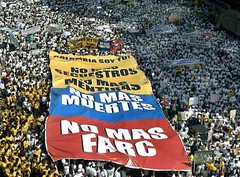|
Revolutionary Armed Forces of Colombia - FARCPeople's Army (Spanish: Fuerzas Armadas Revolucionarias de Colombia – Ejército del Pueblo; FARC-EP, or simply FARC) The Revolutionary Armed Forces of Colombia and ELN. This is a Marxist–Leninist guerrilla organization based in Colombia. WARNING! GRAPHIC/DISTURBING IMAGES The editors won't go into a long drawn out history of these groups in Colombia, since they've only been in existence as a military extension of what was the ColombianCommunist Party following the aftermath of La Violencia in 1964. Our focus will begin when Álvaro Uribe served his Presidency (2002–2010), to the current state of affairs. Juan Manuel Santos who has been Colombia's President since August 7, 2010 has forcefully picked up where Uribe left off. Santos has pledged to continue Bogota’s policy of aggressive military operations—known as Democratic Security—against the FARC. As the Uribe's former defense minister, Santos has publicly vowed to strengthen Colombia’s military and police forces in order to defeat these communist groups and end the conflict which is now nearly 50 years to long. A promise he has been keeping that gets documented through the media outlets. In these recent years FARC has taken some serious blows by the many killing and capture of the group’s high ranking military officials. Most recently killed was Alfonso Cano in a firefight on November 4, 2011. It is documented most of its funding, which has been estimated upwards of $300 million per year, comes from taxation of the illegal drug trade, ransom kidnappings, bank robberies, and extortion of large landholders, multinational corporations, and agribusiness. The taxation of illegal drugs is better defined as paid protection from the Colombian drug cartels. Thankfully the push & focus of the Colombian government in eradicating this vermin has substantially dropped their numbers serving this selfish cause. Once at a high of 18,000, the Colombian government now estimates the numbers have been decimated to approximately 8,000 today. The people of Colombia have grown tired of the actions of the Para military groups in Colombia. Though Colombia’s widespread support has never been there. It is very promising in outrage the population has shown in supporting the defeat of these groups. Colombia's tolerance for what FARC "says" they stand for vs. their actions that bring forth the negative impact felt by all is coming to an end. Their communist beliefs underpins as a selfish group driven only by money & want of power for few at the cost to many. These right-wing paramilitaries all train teens to be their soldiers and informants. Human Rights Watch estimates that nearly one quarter of the guerrillas are in fact, less than 18 years of age. Forcible recruitment of children, by either side, is rare, but it does happen. Most of the children join of their own will without any threats of force to themselves or their families. Manipulation of the young fertile mind is the key factor in recruiting. They join for a variety of reasons including poverty, lack of educational opportunities, avoiding work in the coca processing plants (which is dangerous), escaping from domestic violence, offers of money (mostly from paramilitaries, who pay their soldiers), are just a few reasons. Human Rights Watch has noted that "once integrated into the FARC-EP, children are typically barred from leaving." The purpose of this page was not to give any credence, but to dispell the myth Hollywood and shock reporting has created. Visiting Colombia is not as dangerous as some with the bully pulpit would have you to believe. As with any place your accustomed to in your own developed city or country, there will be areas to consider for your safety. Consider the gangs & violence with any major city...that does not keep you from enjoying, you decide to stay away from their nests.Colombia is no different. Colombia's people have decided the benifits are far greater to extinguish these groups, than to have them hold down the marketplace, economy, & expantion for positive growth for themselves, their children and generations to come. FARC has little stronghold on Colombia present day with little pockets spattered about. The largest pockets along the Venuzualen border, where they scurry like rats into the protection of Chavez, or in the southern region hiding in the jungle.
|











